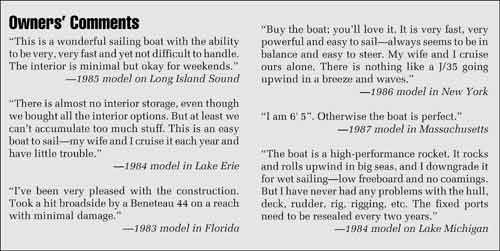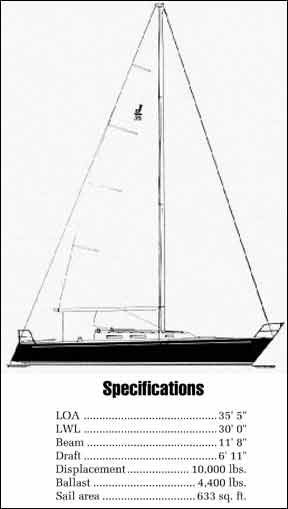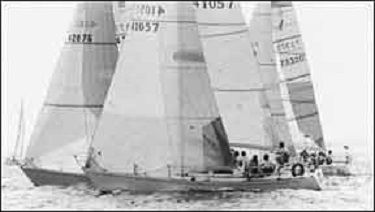The “J” stands for Johnstone and the “35” stands for 35 feet. Straightforward—a characteristic of both the boat and the company that sells them.
The Johnstones were originally two: Rod Johnstone started things in 1976 when he designed a 24-footer and built it in his garage. He convinced his brother, Bob Johnstone, that the boat could be a success, and Bob became chief salesman, in charge of the business.
The relationship continues to this day, but the family owned company is now run by children of both Johnstones, all serious sailors like their parents. Rod’s sons Jeff, Alan, and Phil are president, vicepresident, and legal counsel respectively. Bob’s son Stuart is chairman of the board and marketing manager, while second son Drake oversees the dealer network and is sales manager of the company.
The original J/24 was sold as a “fast” boat that ignored the existing racing rules. At the time, there was a large group of serious racers who felt that the handicap rules, particularly the International Offshore Rule (IOR) and the Midget Ocean Racing Club (MORC), were encouraging unhealthy extremes in design—not necessarily good, fast sailboats, but rather boats that would sail marginally faster than their low handicap ratings said they should sail, boats that required huge crews to go fast.
At the time, the word on the J/24 was that it spit in the eye of the rules; Rod Johnstone had designed a boat that went fast and was fun to sail, and if it didn’t do well in the handicap rating game, then it was the game that was at fault. Except for a couple of aberrations—a 34 and a 41 designed to beat the IOR rule—the J/Boats have remained faithful to that idea. And it is significant that the rating rules have come around to the J/Boats, rather than vice versa. There are more J/Boats than any other brand, by far, racing under the current PHRF and IMS handicap rules.
Unlike most sailboat companies, J/Boats decided from the beginning to stay out of the boatbuilding end of the business. Rather than a J/Boat factory, the completed boats come from Tillotson-Pearson, an independent company whose president, Everett Pearson, was one of the pioneers of fiberglass boatbuilding.
The arrangement has been mutually satisfactory over the years, with J/Boats having relatively little invested in manufacturing overhead, concentrating on the design and marketing; and Tillotson-Pearson has another steady and successful customer to complement the other lines of boats that they build—Alden and Garry Hoyt’s new Manta 32—along with some high-tech endeavors, such as fabricating giant carbon-fiber propellers for wind generators.
Over the years, Tillotson-Pearson has established a reputation for high-quality production work, often at the leading edge of fiberglass technology, that has helped J/Boats maintain an image of quality near the top-end of the production spectrum.
The J/35 was a successful racer from its introduction in 1983, and with more than 300 built so far, it has had a successful production run for the company. The 35 is still available as a new boat and will continue to be. A new design, the 35C, is unrelated to the 35, a different design, slower, aimed more at cruising than the original 35.
In design, the 35 looks like a typical Rod Johnstone boat, with short overhangs for a long waterline, relatively low and flat sheerline, a low cabin house, and a moderate well-balanced rig. Obviously, Johnstone knows something about the harmony between a boat’s underbody and the water, but a large part of the boat’s speed is also dependent on the light weight—10,500 pounds on a 30-foot waterline—as well as a good distribution of that weight.
Traditionalists may think the J/35 is a little plain, but its proportions are pleasing, and many people consider it the most attractive grand prix racer around. If you didn’t know the boat’s record, you probably wouldn’t pick it out of a crowd as a speedster, or know that it’s one of the most successful racing boats its size of the 1980s.

The boat has primarily been known as a racer, but the company touts it as a shorthanded cruiser as well. The boat’s big cockpit, while principally designed for a racing crew, does make the boat good for day sailing, ideal for taking out guests and for dock partying. The boat has frequently been involved in singlehanded racing (both Tony Lush and Francis Stokes raced J/35s across the Atlantic), and we would agree with the company that it is easily handled by a couple, and could make for good cruising for two people or a family with small children.
Though the hull is a bit more beamy and saucer shaped than would be ideal in an offshore boat, it is one of the few modern racers under 40 feet in which we would consider doing an ocean crossing. In storm or hurricane conditions, it has a greater chance of achieving inverse stability than a narrower, heavier boat, but its speed makes it more likely that the prudent sailor will be able to sail away from such extreme conditions.
Construction
As is necessary to make a strong but lightweight boat, the J/35 uses some sophisticated construction techniques. Both the hull and deck are balsa-cored, with the end-grain balsa inside layers of biaxial and unidirectional fiberglass. As with any cloth, there is less stretch and more strength parallel to the glass fibers than across them, and the biaxial and unidirectional cloth used by Tillotson-Pearson lets the builder arrange the cloth throughout the hull so its strength is in line with the forces that occur under sail.
Unlike most boats, the main structural bulkhead which takes the forces of the rig is a molded fiberglass piece, and the floors are made up of glass beams to which both the mast step and the external lead keel are fastened.
The hull and deck are strong and, perhaps more importantly, stiff, so that there is a minimum of flexing when the boat is being pushed. The quality of the construction is evident in the six- and seven year-old boats that are still able to handle the rig forces of a pumped-up backstay on a hard beat.
We have a lingering concern about the longevity of balsa-cored boats, since we have seen many 10- to 20-year-old boats with deck delaminations and a few with substantial delamination in the hull. Tillotson-Pearson obviously disagrees with us and continues to be committed to balsa cores.
With other builders, a major part of our concern is that balsa cored laminates seem to be more demanding of good engineering and high-quality workmanship than solid fiberglass laminates. Tillotson- Pearson is one of the few companies that we would trust to consistently do a good job in laying up a balsa-cored hull.
An unusual feature of hulls built after 1988 is that the company provides a 10-year warranty against blistering. In molding the boat, they use a vinylester resin on the first layer inside the gelcoat, and—along with a clean shop and careful workmen—they think this is enough to warrant the guarantee. The guarantee is transferable to later owners.
New J/35s can also be purchased with an American Bureau of Shipping (ABS) certificate. ABS is similar to the better known English Lloyd’s certification, in that an independent surveyor periodically checks the shop and the boat during construction to make sure it meets minimum standards. While relatively new to cruising sailors, ABS certification is important to racers in the top echelons. International offshore regattas require it. It seems worthwhile because it is about the only way buyers can get an independent evaluation of the boat without overseeing the entire construction process themselves.

The boat comes with a thorough list of standard equipment. The company lists only 18 options for a new boat, and most of these are aesthetic preferences or cruising options, such as a dark-colored hull, two-tone deck, V-berth, swim ladder, and propane locker.
The rig is excellent, with a Hall Spars mast, rod rigging, and complete state-of-the-art running rigging. All winches are adequate, but if we were planning shorthanded cruising in addition to racing, we would consider larger, self-tailing primaries.
Tiller steering is standard on the boat. In its latest brochures, the company doesn’t even list wheel steering as an option, but many earlier models had wheels, and some owners may still want it installed. We sailed both a tiller model and a wheel and believe the tiller is far superior, especially for racing. However, wheels seem to be sufficiently in vogue that there are a preponderance of them on the used 35s for sale.
Interior
The J/35 is primarily a racing boat, and its interior is spartan compared to similarly sized cruising boats. But the interior is decent, and well-finished given the plainness of the boat. The company advertises the high-quality of the interior woodwork, but we would describe it as so-so—better than the cheapest production boats on the market but definitely not “yacht” quality.
The arrangement is conventional. Forward you will find either sail bins or an optional V-berth, decently sized, with a head just aft of that, and a hanging locker and bureau opposite. Two comfortable settee berths are aft of the main bulkhead in the saloon, with an optional fold-up table between them.
The galley is minimal, with a two-burner alcohol stove and sink on the port side and an ice-box with chart-table top opposite. There are two big quarter berths underneath the bridgedeck and cockpit.
Ventilation is good, with eight opening ports and two hatches in addition to the companionway, but there is no provision at all for pushing air through the cabin when underway.
Storage is minimal, adequate for a racing crew or for a couple on a short cruise, but every 35 we looked at had sails and crew gear spread all over the settees and berths.
We would be quite comfortable weekending or cruising on this boat, but it does lack the amenities which most people demand nowadays, like hot-and-cold pressure water, propane stove and oven, and refrigeration. All these things could be added, of course, but they rarely are because they represent weight which is anathema to the high-performance sailor.
For us, the main shortcoming of the interior is the lack of headroom forward, in the head and V-berth, and a tall person will be uncomfortable even in the main cabin.
While this interior may not sound like much to the cruising sailor who looks at other boats with VCR stations and queen-size after berths, it is far superior to the one-off custom racers and almost all other racing boats that are in the same speed class as the J/35. Though the “cruiser” part is minimal, this boat is a true racer-cruiser. Where compromises are made, the racer is clearly favored, but the owner won’t feel compelled to check into a motel at the end of a long passage as is the case with most racing machines.
Under Power
The Yanmar 3GM engine has become almost a standard in this size boat. It is a good engine, dependable, relatively quiet, and its 28 horsepower is plenty big for the J/35. A 20-gallon fuel tank gives about 150 miles of range, adequate since this boat will still be sailing in light airs when most others have cranked up the diesel. The boat comes standard with a Martec folding prop, and the boat powers easily to hull speed. The J/35 turns sharply and handles well under power, and it will back up more or less where you want it. Access to the engine is decent, behind the companionway steps underneath the cockpit. Installation of the engine and the other mechanical systems is workmanlike—good but nothing spectacular.

Under Sail
Sailing is what this boat is all about. We sailed twice on a 35 during their first two years of production, and again last fall, in two heavy-air triangular races.
The boat is obviously quick. With a PHRF rating around 70, it is significantly faster than almost all boats its size. It is 50 seconds-per-mile faster than our own 16-year-old Carter 36 and most other IOR racers between 34 and 37 feet. In the class we raced in last fall, only a Schock 35, and a C&C 37 were comparable in speed. Like most good sailing boats, the J/35 has an “effortless” quality about its motion through the water. To us, it seems that most boats make quite a fuss as you push them up toward hull speed, especially on a beat. Often, you can “hear” how fast you’re going by the amount of noise the boat makes. But a J/35 moves easily up to speed, and you have to look at the knotmeter to know whether you’re moving five knots or seven.
It’s a well-balanced boat, with excellent feel (if you have a tiller model) on all points of sail.
The boat can be wet working to weather in waves, especially given the lack of cockpit coamings, but otherwise it has few faults in sailing. Unlike many high-performance boats, it’s also quite forgiving, so an inexperienced helmsman and crew can achieve good speed and at least finish a race or a passage ahead of other boats, even if losing on handicap.
Conclusions
The J/35 is a pricey boat. A new basic boat will run over $100,000 ready to race, and if you add premium electronics and get into the high-tech sail game, you can up the ante considerably.
However, unlike most boats these days, the J/35 will likely hold its value quite well. The boat will continue to appeal to the die-hard racer and thus maintain its value better than most other boats.
It is obviously not a boat for everybody. If you’re looking for a weekend cottage or a floating condominium, go elsewhere. But if you are in the group of sailors who want a boat between 30 and 40 feet, whose time afloat is spent more than 50 percent in racing, you might want to consider the J/35. And if we were rolling in dough, we’d have to have one to park out in front of our condo, just for the fun of sailing it.
For the used boat shopper, the main consideration after price will be the quality of equipment, especially sails. Unlike some boats, it is quite probable that a J/35 has been raced, and usually raced hard, so in many instances a total refit of the basic boat may be in order.
Given that the latest models have several advantages—an ABS certificate and a 10-year anti-blister warranty—most used boat shoppers will probably want to also go the extra distance to get a new boat.
We like the J/35.
It gets down to basics—if sailing is what sailing is all about, you won’t find a much better boat anywhere.





































